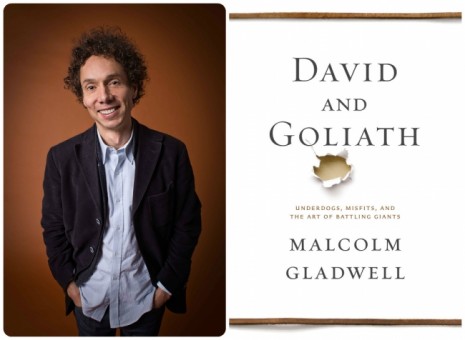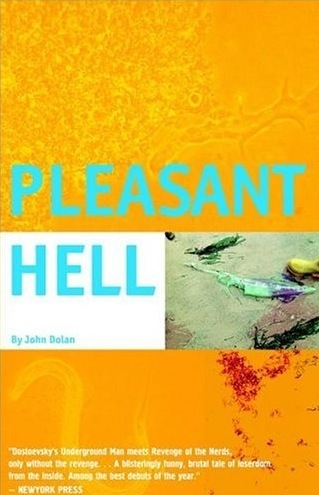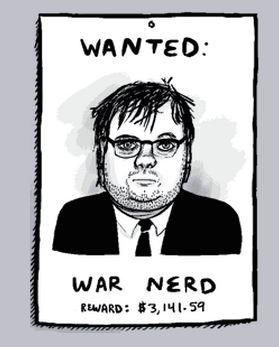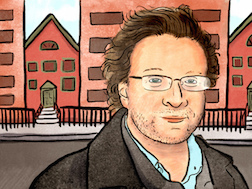
Ever since Malcolm Gladwell’s “David and Goliath” came out in early October, he’s been on a non-stop promotional tour. He’s appeared on the BBC and the Daily Show, he’s done Twitter group chats and Ted Talk Q&As, and has had negative and positive reviews published in dozens of media outlets, including the New York Times, the Wall Street Journal and the Guardian. But despite all this PR attention, as far as I can tell, no one’s really described in plain English what the book is about. And that’s just weird…
So let me be the first: The book is about pitying the rich. Its central thesis: being poor, crippled and/or discriminated against helps you succeed in life.
“We spend a lot of time thinking about the ways that prestige and resources and belonging to elite institutions make us better off. We don’t spend enough time thinking about the ways in which those kinds of material advantages limit our options.”
“David and Goliath” is the right book for our times. America is in the grips of historic economic inequality, unemployment and misery; it’s being looted and trashed by finance hucksters and extraction industry oligarchs, while its citizens are disengaged and distracted and too tired and overworked to really do much about it.
Gladwell offers to soothe this swirling world of shit, misery, exploitation and corruption with a simple counterintuitive message: People who live paycheck to paycheck or dig in the trash, well, they’re not as disadvantaged as popular wisdom would have us believe. The truly disadvantaged are the rich. Because wealth, power, mansions, Porsches, private jets, servants, elite private schools, influence and access — all those great things — are barriers preventing them from realizing their true potential and achieving success. In short: Wealth holds you back.
It’s an ambitious theory, and Gladwell goes to great lengths to prove it. He circles the globe, traveling from Los Angeles to Birmingham to Belfast, seeking out fascinating people, touching stories and counterintuitive science to show his readers that everything they think they know about wealth, privilege and advantage is wrong.
It’s quite a trip. Along the way, he offers comfort and consolation to a Hollywood tycoon because he “had too much money,” consoles a young woman from a well-to-do family who ruined her life by attending an Ivy League university, cites an anti-union economist to prove that cramming kids into classrooms like sardines improves education, and then grieves for kids enrolled in top tier private schools because of their extremely low student-to-teacher ratios.
“A half-hour drive up the road from Shepaug Valley, in the town of Lakeville, Connecticut, is a school called Hotchkiss. It is considered one of the premier private boarding schools in the United States. Tuition is almost $50,000 a year. The school has two lakes, two hockey rinks, four telescopes, a golf course, and twelve pianos. And not just any pianos, but, as the school takes pains to point out, Steinway pianos, the most prestigious piano money can buy. Hotchkiss is the kind of place that spares no expense in the education of its students. The school’s average class size? Twelve students. The same condition that Teresa DeBrito dreads, Hotchkiss—just up the road—advertises as its greatest asset. ‘[Our] learning environment,” the school proudly declares, “is intimate, interactive, and inclusive.’Why does a school like Hotchkiss do something that so plainly makes its students worse off?“
It’s all very sad and moving, especially when you consider that Hotchkiss produced so many notable losers that there’s a Wikipedia page dedicated only to listing famous Hotchkiss School alumni. But this is just the beginning of Gladwell’s epic story.
“David and Goliath” isn’t only about how rough the wealthy have it. Gladwell also tells the inspiring stories of folks who climbed out of crushing poverty, overcame their physical handicaps and clawed their way to dizzying heights of success — all while interspersing them with philosophical musings on the nature and interconnectedness of struggle, suffering and success: “If you take away the gift of reading, you create the gift of listening. If you bomb a city, you leave behind death and destruction. But you create a community of remote misses. If you take away a mother or a father, you cause suffering and despair. But one time in ten, out of that despair rises an indomitable force.” Now that’s deep, man.
Gladwell introduces you to Goldman Sachs President Gary D. Cohn, whose childhood struggle with dyslexia is what made him the successful finance huckster that he is today. You also get to visit the home of pioneering oncologist Jay Freireich, who helped develop the first treatment of leukemia because he grew up in a poor Hungarian immigrant community during the Great Depression, had his father abandon the family and watched his mother waste away in a sweatshop:
“Freireich had the courage to think the unthinkable. He experimented on children. He took them through pain no human being should ever have to go through. And he did it in no small part because he understood from his own childhood experience that it is possible to emerge from even the darkest hell healed and restored.”
Hallelujah! What an uplifting story! Just think of all the future pioneering doctors and scientists that will be forged in today’s economic depression! There are an estimated three million children in the US living in third-world-level “extreme poverty” subsisting on “$2 or less, per person, per day.” Who knew that all that squalor and hardship was really an investment into their future! It would be criminal to allow the government to help these kids — these future inventors and finance tycoons — with “beneficial” programs like food stamps, healthcare or better education. If we were to help them now, we’d be robbing these poor kids of their last valuable possession: the democratic opportunity to strive and struggle and scrape to success!
What data does Gladwell use to prove his novel survival-of-the-fittest social theory? Well, there’s the problem: academic types have been tearing into the book’s shoddy methodology. In reviews published in places like the Wall Street Journal, the Atlantic, the Guardian, Slate and The New Statesman, these pointy head critics accused Gladwell of cramming his book with so many contradictions, inconsistencies, simplifications, half-truths and newagey babble that it made his conclusions irrelevant and untrustworthy. The criticism has been so diverse and sustained that Gladwell was forced to respond.
“If my books appear to a reader to be oversimplified, then you shouldn’t read them: you’re not the audience!” he yelled during an interview with the Guardian. He even published a weird personal attack against one of his critics, a Union College psychology professor by the name of Christopher Chabris, bringing Prof. Charbis’ wife into the fight, writing: “I clearly drive her crazy, too. These are not tranquil times in the Meyer-Chabris household.”
Despite all the criticism, the book’s been a best seller. And that’s because Gladwell’s pity-the-billionaire theory has a lot of admirers. Slate’s neoliberal blogger Matty Yglesias loved the book. So did best-selling libertarian economist Dr. Tyler Cowen, of George Koch-Mason University. Here’s how he reviewed “David and Goliath”:
“Quite possibly it is Gladwell’s best book. His writing is better yet and also more consistently philosophical. . . . it so unambiguously improves the quality of the usual public debates, in addition to entertaining and inspiring and informing us, I am very happy to recommend it to anyone who might be tempted.”
There’s a reason why Dr. Cowen is so enthralled with with “David and Golaith.” He’s one of the most respected bagger economists alive today. And as such, Dr. Cowen believes that oligarchs get a bad rap. For instance: in his professional opinion, the current economic recession has hurt the rich more than any other class. Meanwhile it has been a downright godsend for America’s poor, allowing them to relax more and eat better.
“In any recession, the poor suffer the most pain… But it is less widely known that in the United States and other affluent countries, physical health seems to improve, on average, during a downturn. Sure, it’s stressful to miss a paycheck, but eliminating the stresses of a job may have some beneficial effects,” wrote Cowen in a 2009 New York Times op-ed. He pointed a few other reasons why economic depressions are great for the unemployed, including that they “spend less on alcohol and tobacco” and “have more time for exercise and sleep.” According to Mr. Cowen, it’s the rich who experience the greatest amount of suffering: “…it may well be the rich who lose the most in the current crisis. . . . We can expect a shift away from the lionizing of fancy restaurants, for example, and toward more use of public libraries.”
Just think of the three-star Michelin restaurants standing neglected, and all the luxury yachts abandoned at their slips! Think of all the fine sailing trips to the Bahamas and St. Kitts that never got underway! These wealthy folks really do suffer more than any of us poor and middle-bracket earners could ever know!
Now that’s a bagful of counterintuitive wisdom that Gladwell can get behind!
Gladwell argues that poverty can be great for you, but he’s no dope or simpleton. He understands that too much struggle and too much despair can be a bad thing. It can hold you back in your success and lead to what he calls an “undesirable difficulty.” One such undesirable difficulty: affirmative action.
Affirmative-action programs were designed to help African-American students attend good universities and add diversity to the student population, but Gladwell spends quite a lot of space arguing that these programs do the the opposite of what they were designed to achieve. That’s because elite universities are just too darn difficult for affirmative-action students. The kids can’t handle the workload, get discouraged and get poor grades. In the end, says Gladwell, affirmative-action students would be better served by attending less prestigious colleges where competition is not as intense. “That doesn’t mean affirmative action is wrong. It is something done with the best of intentions, and elite schools often have resources available to help poor students that other schools do not,” Gladwell writes. He then concludes: “I am now a good deal more skeptical of affirmative-action programs.”
So to sum up: Poverty and deprivation foster the good kind of struggle that helps you grow. But letting black kids attend universities that challenge them to think and do better…well, that’s just taking the struggle way too far.
In one of the weirder and more disturbing segments of the book, Gladwell tells the story of how the civil rights movement triumphed against the cops of Birmingham, Alabama, and won the hearts and minds of the American public. But in his neoliberal retelling, Martin Luther King and top civil rights organizers are transformed from moral and political activists into a bunch of scrappy PR guys who won because they ran a guerrilla marketing campaign that was better and smarter than that of their segregationist opponents.
To prove his point, Gladwell zeroes in on a famous photograph from a May 1963 demonstration in Birmingham that was brutally broken up by firehoses and police dogs. The picture shows a K-9 cop in a crisp uniform, dark aviator glasses and roundtop hat grabbing a lanky black student by the name of Walter Gadsden, while a snarling German shepherd prepares to maul the kid’s groin. The photo ran on the front page of the New York Times, and it was at the time so shocking and disturbing that President John F. Kennedy worried that it would help the Reds expand their influence. Gladwell credits the photo with helping turn public opinion in favor of the civil rights movement, and forcing the federal government into action…
That photo was clearly powerful and iconic, so much so that the vicious police German shepherd has been immortalized with a bronze statue standing in Birmingham today. But according to Gladwell, the picture was a PR gimmick and clever trick.
The way he tells it, conditions on the streets of Birmingham that day weren’t as violent as the people were led to believe. Sure, multiple news reports, eyewitness accounts and photographs showed police dogs attacking black protesters, biting them and ripping their clothes. Gladwell says photos can be deceptive. The truth is that Birmingham’s K-9 unit wasn’t known for violence, racism or bigotry. They were generally nice guys who just happened to be taking their pups out for a walk that day. If you analyze the photo carefully you can see that the police officer and his snarling German shepherd are not the aggressors. They are the victims of a raging black youth who decided to have a bit of fun by kicking the poor mutt in the jaw.
Here’s Gladwell:
“The officer in the picture is Dick Middleton. He was a modest and reserved man. . . The dog’s name is Leo. Now look at the faces of the black bystanders in the background. Shouldn’t they be surprised or horrified? They’re not. Next, look at the leash in Middleton’s hand. It’s taut, as if he’s trying to restrain Leo. And look at Gadsden’s left hand. He’s gripping Middleton on the forearm. Look at Gadsden’s left leg. He’s kicking Leo, isn’t he? . . . Gadsden wasn’t the martyr, passively leaning forward as if to say, ‘Take me, here I am.’ He’s steadying himself, with a hand on Middleton, so he can deliver a sharper blow. The word around the movement, afterward, was that he’d broken Leo’s jaw. Hudson’s photograph is not at all what the world thought it was.
In reality what happened that was that black protesters taunted the police and sparked the confrontation with the aim of getting some sympathetic press. There was no real bloodshed or violence, and the protest was actually fun and exciting for the black folks involved. But of course that’s not how it was reported by the national press hungry for racy headlines, which hyped the violence and compared Birmingham to apartheid South Africa. So in the end, the Americans were duped into supporting the civil rights movement by a crafty PR strategy and sympathetic news media.
It’s a very strange revisionist history that strips all the moral and political elements of the civil rights movement out of the story, reducing it to marketing strategy and tactics. But it’s also something potentially much more sinister: it promotes the idea that race relations in the South were not as bad as people believe, and that the civil rights movement was some sort of hoax.
Who believes in this conspiracy theory? Take neo-confederate Alabama governor George C. Wallace. He was convinced that the civil rights movement — and the Civil Rights Act that it inspired— was a diabolical plot to impose a tyrannical neo-reconstruction regime on Southern states by pinkos in the federal government. That view is still very much in circulation today. In fact, a decade before “David and Goliath” came out, extreme-libertarian website LewRockwell.com published a column by a fringe pro-slavery white supremacist named Gail Jarvis. The article described Birmingham’s protests in almost exactly the same way as Gladwell: that the liberal media elite colluded with uppity southern blacks to stage the civil rights hoax.
“I was a resident of Birmingham during the most turbulent part of the 1960s and I have always wanted to tell ‘the other side of the story.’
“I simply wanted to report what wasn’t reported and illustrate how activists, politicos and media collude to stage-manage the news.”
In addition to exposing the civil rights conspiracy, Jarvis wants to abolish the U.S. Department of Education because it’s engaged in “indoctrination and behavior modification.” He also thinks blacks were much better off as slaves: “it is a fact that [the] black male would have been much safer in the old Confederacy in the 19th [century].”
Now, if you’re asking yourself why Malcolm Gladwell, a celebrity journalist for the New Yorker magazine, is spiking his book with libertarian ideology, anti-union propaganda and weird borderline neo-confederate revisionism…well, then you clearly don’t know much about Malcolm Gladwell.
Malcolm Gladwell might be a bestselling author and a cult NPR thought-leader ranked as one of the world’s 100 most influential people by Time magazine, but he’s got a long and sordid history that goes back to his days as a Reagan college conservative trained in the bowels of the corporate thinktank world. Specifically, he was indoctrinated at the National Journalism Center, a business-funded outfit designed to mold college kids into journalist-moles in order to combat the alleged “anti-business bias” of the news media. Philip Morris, one of its major supporters, said that the mission of the NJC was to “train budding journalists in free market political and economic principles.”
Over the years the National Journalism Center has produced hundreds of pro-business operatives and landed them in top-tier media jobs, and that includes Gladwell. Starting from the Washington Post and continuing into his current gig at The New Yorker, Gladwell’s used the pages of prominent media outlets to run cover for pharmaceutical companies, big tobacco, the health insurance industry and Wall Street fraudsters — all while pocketing serious cash as a sought-after corporate speaker. Just on his speaking racket alone, Gladwell earns at least $1 million a year from a diverse set of clients, including Philip Morris, Lehman Brothers, Microsoft, Bank of America, PricewaterhouseCoopers and the health insurance mega-lobby AHIP — many of the same companies he’s covered as a journalist.
It’s not widely known, but Philip Morris — which helped underwrite Gladwell’s early career as a journalist — loved his work so much that it named him in a confidential document as one of its top media assets, right along with Grover Norquist and Milton Friedman. Philip Morris’ top brass loved Gladwell’s first book, “The Tipping Point,” for its defense of the tobacco industry’s strategy of using advertising to lure young smokers. “I recommend you read (or have one of your minions submit a book report on) The Tipping Point, by Malcolm Gladwell . . . Beyond the piece on teen smoking, there is some interesting, possibly useful, information,” wrote Philip Morris exec Michael Fitzgibbon in an email to the company’s resident behavioral scientist.
Compared to his older work, there’s something disturbingly fatigued and pitiful about “David and Goliath.” The counterintuitive voodoo is duller, the counterfactual logic less crafty, the claims less daring…He’s clearly tired and believes his own inane bullshit even less than usual, but is still going through the motions. And why not? Gladwell’s done well for himself. He’s got three bestsellers, does script deals with Hollywood and is quite possibly the most famous essayist/journalist in America, a man who has the media hang on to his every word. Just last year, he bought his third million-dollar apartment in a New York’s West Village building where rent runs about $12,000 a month.
He’s made his millions, and now he’s got only one simple message: pity the rich.
This article was originally published by NSFWCORP.
Read more: 1%, book review, malcolm gladwell, yasha levine, Yasha Levine, Books, NSFWCORP


Got something to say to us? Then send us a letter.
Want us to stick around? Donate to The eXiled.
Twitter twerps can follow us at twitter.com/exiledonline















1 Comment
Add your own1. Max | January 10th, 2015 at 8:28 am
A couple of questions about some points in this piece:
Why would Gladwell be a Reagan college republican if he’s canadian and went to University of Toronto?
Why would Gladwell be anti-civil rights or anti-black since he himself is half-black?
Leave a Comment
(Open to all. Comments can and will be censored at whim and without warning.)
Subscribe to the comments via RSS Feed